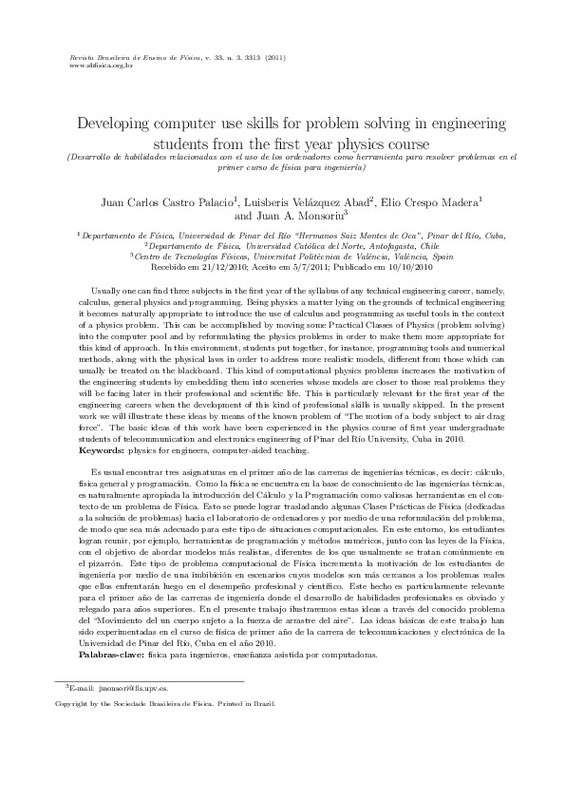Riera, J., Giménez, M. H., Vidaurre, A., & Monsoriu, J. A. (2002). Digital simulation of wave motion. Computer Applications in Engineering Education, 10(3), 161-166. doi:10.1002/cae.10025
Vidaurre, A., Riera, J., Giménez, M. H., & Monsoriu, J. A. (2002). Contribution of digital simulation in visualizing physics processes. Computer Applications in Engineering Education, 10(1), 45-49. doi:10.1002/cae.10016
Monsoriu, J. A., Villatoro, F. R., Marín, M. J., Urchueguía, J. F., & Córdoba, P. F. de. (2005). A transfer matrix method for the analysis of fractal quantum potentials. European Journal of Physics, 26(4), 603-610. doi:10.1088/0143-0807/26/4/005
[+]
Riera, J., Giménez, M. H., Vidaurre, A., & Monsoriu, J. A. (2002). Digital simulation of wave motion. Computer Applications in Engineering Education, 10(3), 161-166. doi:10.1002/cae.10025
Vidaurre, A., Riera, J., Giménez, M. H., & Monsoriu, J. A. (2002). Contribution of digital simulation in visualizing physics processes. Computer Applications in Engineering Education, 10(1), 45-49. doi:10.1002/cae.10016
Monsoriu, J. A., Villatoro, F. R., Marín, M. J., Urchueguía, J. F., & Córdoba, P. F. de. (2005). A transfer matrix method for the analysis of fractal quantum potentials. European Journal of Physics, 26(4), 603-610. doi:10.1088/0143-0807/26/4/005
Smith, R. C., & Taylor, E. F. (1995). Teaching physics on line. American Journal of Physics, 63(12), 1090-1096. doi:10.1119/1.18014
Froese, T., Zhu, D., & Bhat, S. (2001). WWW courseware in applied science: Cases and lessons. Computer Applications in Engineering Education, 9(2), 63-77. doi:10.1002/cae.1007
Mandal, P., Wong, K. K., & Love, P. E. D. (2000). Internet-supported flexible learning environment for teaching system dynamics to engineering students. Computer Applications in Engineering Education, 8(1), 1-10. doi:10.1002/(sici)1099-0542(2000)8:1<1::aid-cae1>3.0.co;2-o
Kaw, A., & Ho, S. (2006). On introducing approximate solution methods in theory of elasticity. Computer Applications in Engineering Education, 14(2), 120-134. doi:10.1002/cae.20070
Kuester, F., & Hutchinson, T. C. (2007). A virtualized laboratory for earthquake engineering education. Computer Applications in Engineering Education, 15(1), 15-29. doi:10.1002/cae.20091
Sieres, J., & Fernández-Seara, J. (2006). Simulation of compression refrigeration systems. Computer Applications in Engineering Education, 14(3), 188-197. doi:10.1002/cae.20075
Johnson, M. (2001). Facilitating high quality student practice in introductory physics. American Journal of Physics, 69(S1), S2-S11. doi:10.1119/1.1286094
Castro Palacio, J. C., Rubayo-Soneira, J., Lombardi, A., & Aquilanti, V. (2008). Molecular dynamics simulations and hyperspherical mode analysis of NO in Kr crystals with the use of ab initio potential energy surfaces for the Kr-NO complex. International Journal of Quantum Chemistry, 108(10), 1821-1830. doi:10.1002/qua.21620
Castro Palacio, J. C., Velazquez Abad, L., Lombardi, A., Aquilanti, V., & Rubayo Soneíra, J. (2007). Normal and hyperspherical mode analysis of NO-doped Kr crystals upon Rydberg excitation of the impurity. The Journal of Chemical Physics, 126(17), 174701. doi:10.1063/1.2730786
Abu-Mulaweh, H. I., & Mueller, D. W. (2008). The use of LabVIEW and data acquisition unit to monitor and control a bench-top air-to-water heat pump. Computer Applications in Engineering Education, 16(2), 83-91. doi:10.1002/cae.20122
Rebolj, D., Menzel, K., & Dinevski, D. (2008). A virtual classroom for information technology in construction. Computer Applications in Engineering Education, 16(2), 105-114. doi:10.1002/cae.20129
Orquín, I., García-March, M.-Á., de Córdoba, P. F., Urcheguía, J. F., & Monsoriu, J. A. (2007). Introductory quantum physics courses using a LabVIEW multimedia module. Computer Applications in Engineering Education, 15(2), 124-133. doi:10.1002/cae.20100
Garrett, S. L. (2004). Resource Letter: TA-1: Thermoacoustic engines and refrigerators. American Journal of Physics, 72(1), 11-17. doi:10.1119/1.1621034
Monsoriu, J. A., Villatoro, F. R., Marín, M. J., Pérez, J., & Monreal, L. (2006). Quantum fractal superlattices. American Journal of Physics, 74(9), 831-836. doi:10.1119/1.2209242
Timberlake, T. (2004). A computational approach to teaching conservative chaos. American Journal of Physics, 72(8), 1002-1007. doi:10.1119/1.1764559
Gillies, A. D., Sinclair, B. D., & Swithenby, S. J. (1996). Feeling physics: computer packages for building concepts and understanding. Physics Education, 31(6), 362-368. doi:10.1088/0031-9120/31/6/016
Galili, I., Kaplan, D., & Lehavi, Y. (2006). Teaching Faraday’s law of electromagnetic induction in an introductory physics course. American Journal of Physics, 74(4), 337-343. doi:10.1119/1.2180283
Wilson, J. M., & Redish, E. F. (1989). Using Computers in Teaching Physics. Physics Today, 42(1), 34-41. doi:10.1063/1.881202
Coulter, B. L., & Adler, C. G. (1979). Can a body pass a body falling through the air? American Journal of Physics, 47(10), 841-846. doi:10.1119/1.11626
[-]









